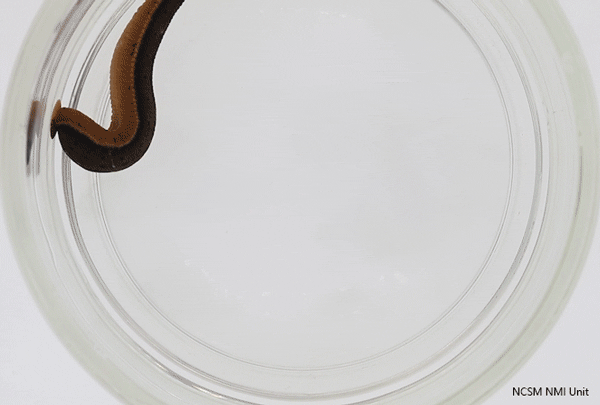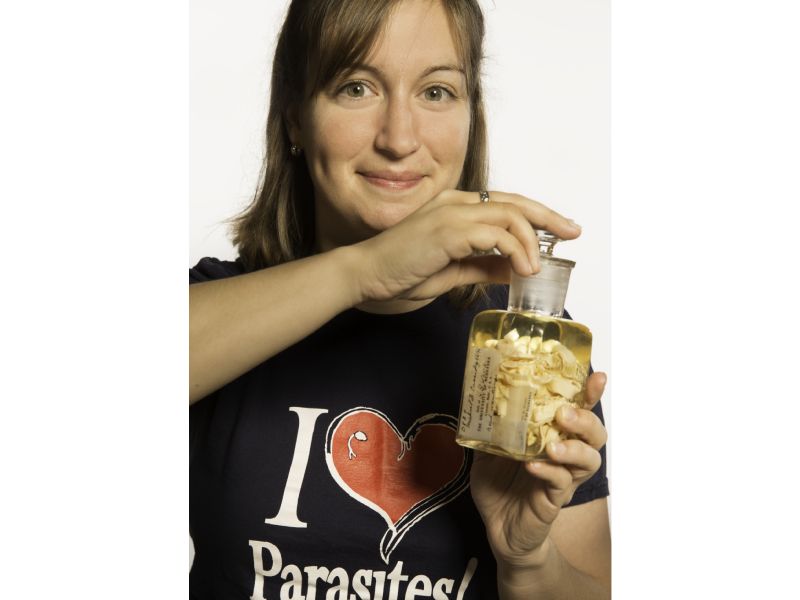A New Species of Leech Is Discovered Near Washington, D.C.
Smithsonian researcher describes a previously unknown species of olive-green bloodsucker that has three jaws with up to 59 teeth
In the summer of 2015, when Smithsonian research zoologist Anna Phillips and other scientists were standing in slow-moving swamp water, letting leeches latch onto their bare legs or gathering them up in nets from muddy pond bottoms, they didn’t realize that some of the bloodsuckers they’d collected belonged to an entirely new species. But in a just-published paper in the Journal of Parasitology, Phillips and her colleagues from the Universidad Nacional Autónoma de México and the Royal Ontario Museum report that a previously unknown leech species, Macrobdella mimicus, is the first to be discovered on the continent in more than 40 years.
An international collaboration investigating biodiversity in leech populations led Phillips, a curator of parasitic worms and invertebrate zoology at the National Museum of Natural History, to streams and ponds across the eastern United States. Wading into the water, she checked rocks and submerged wood scraps for leeches to collect and analyze.
Later, DNA tests on the leeches’ suckers came back with an unexpected result. They showed that for some leech specimens, the genetic fingerprints differed by as much as six and eleven percent from the others. That evidence, says Phillips, stood out like a (blood-)red flag. Scientists know that a genetic difference of more than two percent in a telltale part of the genome typically indicates the two creatures may be distinct species.
“Superficially, this looked like M. decora,” she says, referencing a closely related species of leech with a range that stretches from Canada to the southern states.
The results of the DNA analysis, however, prompted them to give the specimens a closer look.
Parasitologists typically rely on the arrangement of pores on the bottom of leeches’ bodies to help distinguish species. With a close inspection, the researchers noticed a subtle difference in the spacing of the leeches’ accessory pores. (While leeches are hermaphrodites, they mate with other leeches, and accessory pores secrete mucus that allows the mating leeches to stick together.) M. decora had four accessory pores grouped in two rows of two, just like the outlier group, but the new species had a set of pores located several millimeters farther back on their body. The similar pore pattern, however, led Phillips and the other scientists to name the new species Macrobdella mimicus, after the Greek word for “imitator” or “actor.”
The new species is olive-green with orange spots, about as long as a cigarette and as wide as two. It has three jaws, each containing 56 to 59 teeth (fewer than M. decora), which it can use to bite and siphon blood from humans. Leeches like this species can suck two to five times their body weight in blood thanks to expandable pockets in their intestines, explains Phillips.

But the new species wasn’t christened the moment the scientists noticed the DNA sequence discrepancies. The researchers first needed to understand whether the unusual parasites were confined just to Southern Maryland or had a larger habitat.
While browsing images on Flickr, Phillips noticed a photograph of leeches on the leg of a man in South Carolina, a location she wouldn’t expect to see M. decora. She gathered leeches in the state, found more of the new species, and then turned to collections belonging to museums and the federal government in North Carolina, Virginia and the District of Columbia, including the Smithsonian’s invertebrate zoology collection, which includes 5,310 lots of leech specimens. (A lot is a collection of one or more specimens gathered at the same time and place.)
Without the preserved specimens she found in the collections, says Phillips, “it wouldn’t have been possible to know the species so well.”

From the information gleaned from the historical and more recent specimens, a picture of the extent of the new species’ range began to emerge. The creature makes its home in a splinter of land extending from Northern Georgia to Long Island that falls neatly between the distributions of other known medicinal (human-feeding) leech species. Phillips also learned that a M. mimicus leech specimen was collected in New York in 1937. “It’s not something new that’s come up; it’s something that has been there the whole time, unrecognized,” she says.
The last time a new leech species was described in North America was 1975. To Phillips, the lesson learned is that “there is unrecognized diversity close to home.”
“You don’t have to go very far to find something new,” she says.
Because this family of medicinal leeches has been thoroughly studied, “finding a new Macrobdella species is exciting,” says Michael Tessler, a comparative biologist who works with leeches at the American Museum of Natural History, in an email. Tessler, who was not involved with the new research, continues, “Even more amazing is that this leech species, which is distinguishable using external features alone, has avoided detection even though its range spans areas with great histories of collecting.”
A future question for researchers will be to further document the range of M. mimicus to better understand what geographic factors might have led to the divergence of the species from the other members of the Macrobdella genus.